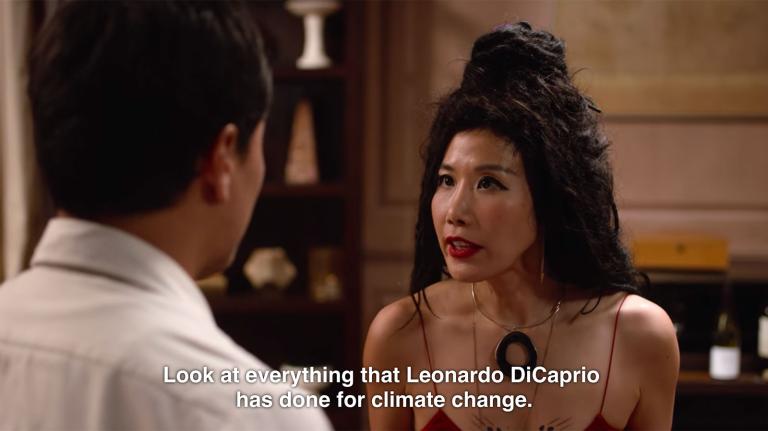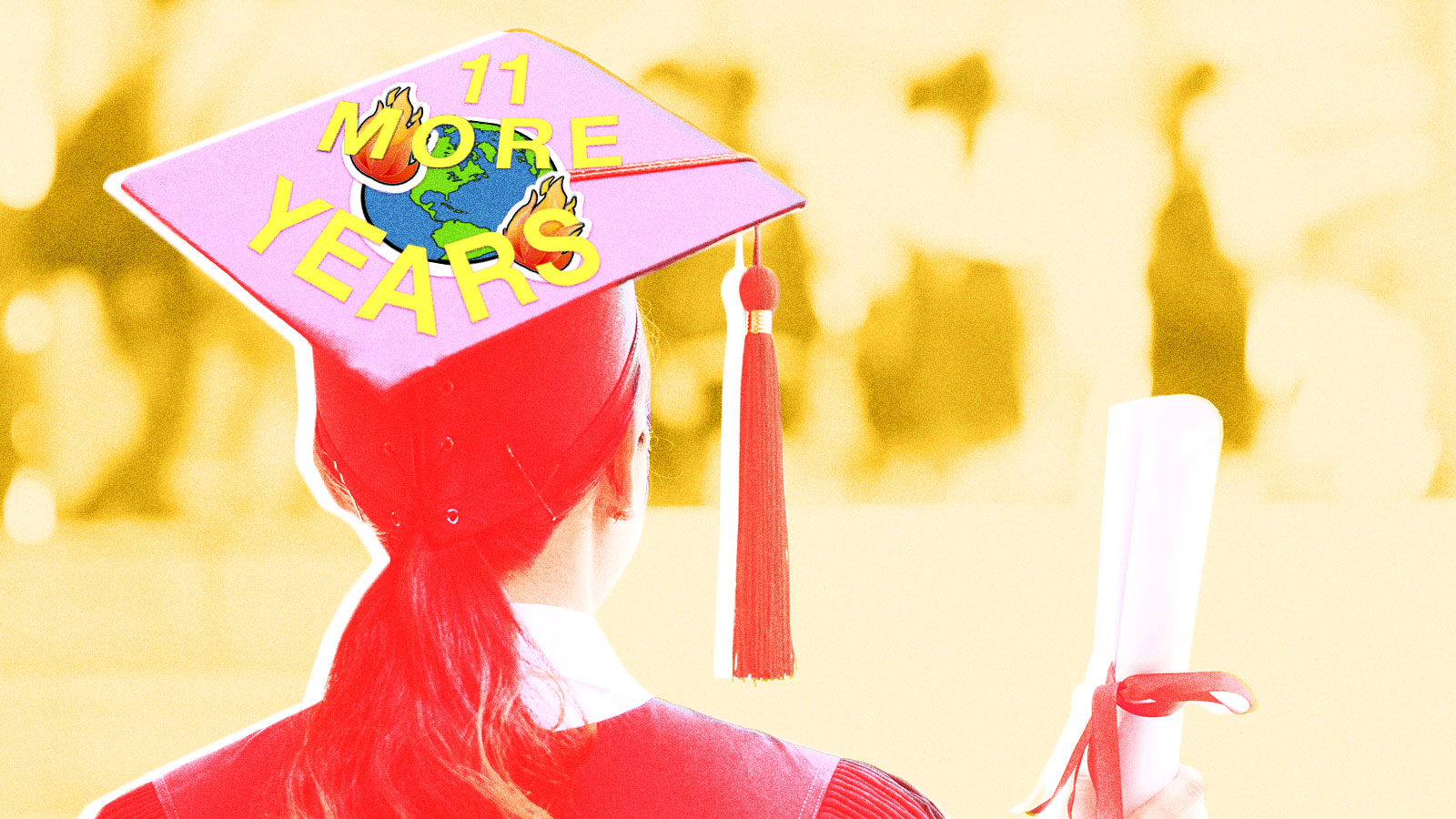It’s June, and that means and millions of college students are done with academic classes and free to focus on more important matters like catching up on sleep, spending time in the great outdoors … and worrying about climate change. But, with few exceptions, college courses haven’t been doing a great job preparing young people to face real-world problems and emotions related to global warming.
Professor Jennifer Atkinson is in charge of one of those exceptions, a seminar at the University of Washington, Bothell on “Eco-Grief and Climate Anxiety.” She likens the course to “boot camp, preparing students for the long, hard fight ahead.” Her class explores climate issues and environmental issues through literature, poetry, film, and the arts. As part of the Winter 2019 offering, students prepared responses from David Wallace-Wells’ grim prognosis of our climate future in ‘The Uninhabitable Earth’ and arranged outdoor experiences. As a final group project, they had to develop a climate change website, handbook, or proposed retreat to help others cope with the “anger, grief, and despair that can arise in the face of our environmental crisis.”
When Atkinson first offered the course last year, she wasn’t sure if students would be interested. But two dozen enrolled, and after word got out about the class, hundreds of messages — most of them supportive — flooded Atkinson’s inbox.
“We should be devoting more [academic] attention to climate change,” she told Grist. “Understanding climate change has become a basic literacy that’s needed to understand everything else in the 21st century.”.
We like to think of academics, especially at the college level, as among the most vocal advocates of climate change. Because you know, FACTS. We’re seeing record-smashing heat; unprecedented storms; and a “fire season” that burns year-round. But while there’s no shortage of scientific evidence supporting global warming being (a) real, (b) caused by humans, and (c) super duper urgent right now, not all high schools and colleges seem to have gotten the memo, even when it comes to the sciences.
Many recent science majors say climate change was not part of the required curricula in their high school or college courses, despite researchers having alerted the public to its importance as early as the 1980s. “I don’t recall ever talking about it in any core chemistry classes,” said Alex Tyson, who graduated from the University of California at Berkeley in 2006 with a B.S. in chemistry. “I took an atmospheric chemistry class as an upperclassman elective and learned a whole lot of the nuts and bolts of climate change … but there might have only been 15 to 20 students in the class.”
At Grist, we spoke to several people who studied subjects relevant to climate change such as biology, public health, engineering, and agricultural science. Many said climate change was optional to learn about, only briefly covered in class, presented as up for debate, or not mentioned at all (though environmental science and ecology majors tended to fare better than those from other science disciplines, as did people who were enrolled in classes more recently). Still, with the Intergovernmental Panel on Climate Change currently projecting less than 12 years to mitigate the worst effects of global warming, science education is lagging behind.
According to a recent NPR poll that found 55 percent of teachers do not cover climate change or even talk to their students about it during class time. But the demand is there — around 80 percent of parents told NPR they wished their kids were getting information about climate change in school, and the vast majority of teachers surveyed (86 percent) said they wanted to include it in their curriculum. The most commonly cited reason educators at the K-12 level gave for not addressing climate change was because it was “outside of their subject area.”
For college science courses, though, that reasoning doesn’t hold up. Our current scientific understanding of global warming and climate change impacts are not the domain of one, quirky field called “climate science.” The climate science community is made up of researchers from many disciplines including geology, astrophysics, oceanography, atmospheric science, the humanities, to name just a few areas of study. So why hasn’t it been traditionally taught? Part of it has to do with the fact that many professors did not necessarily receive that information as part of their own undergraduate training, leaving them with a knowledge gap.
In the 2014–15 academic year, the National Center for Science Education and researchers at Pennsylvania State University conducted a rigorous national survey asking secondary public school science teachers a series of detailed questions about what they know, and what they teach, about climate change. When asked, “What proportion of climate scientists think that global warming is caused mostly by human activities?” only about 40 percent of the responding teachers chose the correct answer: 81 to 100 percent. It’s not surprising then that nearly 60 percent of teachers report encouraging their students to “debate” the causes of climate change, despite the topic being no less evidence-based than, say, photosynthesis.
But that may be starting to change. In light of increasing climate change urgency, a few college programs have been trying harder to keep up with the science. In 2010, the National Science Foundation launched the Climate Change Education Partnership Program (CCEP), aiming to partner with leading universities and educate students, teachers, and the public about global climate change and its impacts. “The topic of climate change is not currently well-represented in national and state science education standards,” according to Jill Karsten, a program director at the National Science Foundation, said in a press release. “We want to prepare individuals and their communities to make their own evidence-based decisions.”
For now, it’s mostly up to individual college professors to update their course offerings to include the current state of climate change.
At the University of Washington, Professor Jennifer Atkinson was inspired to start offering her climate anxiety course to students after over a decade of watching them struggle with the depressing realities of our ecological crisis. A faculty member at the School of Interdisciplinary Arts and Sciences, she’d like to see climate change incorporated into the curriculum in many different disciplines, including the humanities. “The fact that we’re leaving climate discussions primarily to the natural sciences is itself part of the problem,” she said.
At the University of California at Berkeley, a group of professors from various departments also decided to take an interdisciplinary approach to climate education. David D. Ackerly, a forest and plant ecologist, Whendee L Silver, an ecosystem scientist, David L Sedlak, a civil engineer, and Steven A. Weissman, a lawyer — devised a class on “Climate Change and the Future of California” that they began teaching in 2016.
According to Ackerly, students have recently reported hearing more about climate change in their other classes.”I’ve actually seen students reviews now that say, ‘I hear about climate change every class I take’,” Ackerly told Grist. “That’s important good news.”
Like Atkinson’s seminar, the class is not a required for graduation — it’s what at the University calls a “Big Ideas Course,” which is a special program of classes for students from any major — not just the sciences. “We’re educating future voters,” David D. Ackerly, the forest ecologist who helped plan the class. “People in any walk of life will now be dealing in the next 50 years with these new challenges, and the more people know, the better they can do their jobs and bring that understanding to their work.”
Even though some colleges are taking steps to change course, Atkinson said finding out about climate concerns in college may be too late.
“When students get to college and they learn more about the immensity and the urgency of the problem, they’re outraged that it wasn’t a bigger part of their high school education or that it wasn’t a required part of the curriculum even as college students,” she said. They experience that failure as a “double betrayal.” First, that they inherited this colossal existential threat from other generations. Second, they were left so long in the dark about how serious the issue is, giving them less time to figure out how we might address it.




